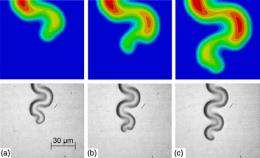March 27, 2012 feature
Scientists investigate mystery of telephone cord buckles

(PhysOrg.com) -- Ranging in thickness from a few nanometers to several micrometers, thin films and coatings play a role in a wide variety of applications. The reflective metal layer on a mirror, the coatings on low-emissivity or colored windows, and the thin silicon layers on thin-film solar cells all consist of thin films. When thin films are compressed with enough force, they can buckle and delaminate under compressive stress. Starting from defects, the buckles propagate, delaminating the film substrate interface on their way. Buckles can be straight, circular, or even take the three-dimensional coiled shape of a telephone cord. Although researchers have studied telephone cord buckling in thin films for decades, they still don't fully understand their propagation mechanisms. A new study now sheds some light on this area.
A team of researchers from France, Jean-Yvon Faou, Sergey Grachev, and Etienne Barthel from CNRS/Saint-Gobain in Paris, and Guillaume Parry from SIMaP (Grenoble Institute of Technology), have published their study on the formation of telephone cord buckles in thin films in a recent issue of Physical Review Letters.
The propagation of telephone cord buckles is more complex than that of other buckling shapes. In experiments, scientists have observed telephone cord buckle formation, assumed to be starting from initial defects. At some point, the propagation front begins to rotate. The rotating buckle sags slightly, and the sagging is immediately followed by a change in the rotation direction. These steps repeat, and the telephone cord buckling grows.
Although scientists can observe these buckles occurring over and over in different thin-film materials, an understanding of the physical mechanisms that cause this coiled morphology to form has remained elusive. Now for the first time, the researchers have developed a simulation of telephone cord buckling that mimics very closely the way that the buckling occurs in experiments.
“The problem is highly non-linear,” Parry and Faou told PhysOrg.com. “It actually mixes the mechanical non-linearity of plates (the buckling thin film) and the physical non-linearity of adhesion. Non-linearities make it difficult to find solutions. In this work we had precise experimental results which helped identify exactly where to look for a solution.”
What makes the problem even trickier, they explain, is that the compression that causes telephone cord buckling is often the same kind of compression that causes other types of buckles.
“In non-linear problems, various solutions may coexist under the same conditions!,” the scientists explain. “So basically it is the same kind of compressive loadings which leads to the different types of buckles. However, a first parameter affecting the morphology is possible stress asymmetry in the plane, while details in the interface energy will also affect buckle patterns.”
The scientists built their simulation based on a suggestion from a previous study that the telephone cord morphology arises from an instability at the buckle front. The new simulation shows that, during the sagging of the buckle, such an instability can cause the sagged area to pin the front of the buckle. This pinning causes the buckle front to collapse, which induces the counter-rotation in the buckle, the defining feature of the telephone cord morphology.
By better understanding telephone cord buckling in thin films, researchers may find ways to minimize or avoid this unwanted buckling in applications.
“It is usually seen as a flaw,” Parry and Faou said. “We like telephone cord buckles because, on the other hand, we hope we can understand adhesion better from the analysis of the buckle morphologies. In addition, the idea of pinning is interesting: we may think that if we understand buckles accurately enough, we could find ways to really pin them down, thus suppressing propagation. This would require specific interface designs.”
More information: Jean-Yvon Faou, et al. “How Does Adhesion Induce the Formation of Telephone Cord Buckles?” PRL 108, 116102 (2012). DOI: 10.1103/PhysRevLett.108.116102
Copyright 2012 PhysOrg.com.
All rights reserved. This material may not be published, broadcast, rewritten or redistributed in whole or part without the express written permission of PhysOrg.com.

















